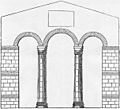Anglo-Saxon architecture facts for kids
Anglo-Saxon architecture refers to the style of buildings made in England and parts of Wales. This period lasted from the middle of the 5th century until the Norman Conquest in 1066. Most Anglo-Saxon buildings were simple. They were often made from wood with roofs of thatch.
There are not many Anglo-Saxon buildings left today. This is because most were built from wood, which decays over time. Also, later buildings often replaced older ones. About fifty churches still exist that were built during this time. All of these surviving churches, except for one made of wood, are built from stone or brick.
Contents
What is Anglo-Saxon Architecture?
Anglo-Saxon architecture describes the buildings made by the Anglo-Saxons. These people lived in Britain after the Romans left. Their building style was quite basic compared to later periods. It focused on practical needs rather than fancy decorations.
Building Materials and Style
Early Anglo-Saxon buildings were mostly made of wood. They used timber frames and filled the gaps with wattle and daub. This was a mix of woven sticks and mud. Roofs were usually covered with thatch, which is dried straw or reeds.
As time went on, especially after the 7th century, stone became more common. This was mainly for churches. Stone buildings were stronger and lasted longer. However, even stone buildings often had simple designs. They used basic shapes and strong, thick walls.
Key Features of Anglo-Saxon Buildings
Anglo-Saxon churches often had tall, narrow towers. These towers sometimes had triangular openings for windows. You might also see "herringbone" patterns in the stonework. This is where stones are laid at an angle, like fish bones.
Doorways and arches were often rounded or had a simple triangular shape. Sometimes, they used "long-and-short work." This is a pattern of long, upright stones alternating with short, flat ones. This made the corners of buildings very strong.
Why Are There So Few Remains?
Most Anglo-Saxon buildings were made of wood. Wood rots away over hundreds of years. This is why we have very few original wooden Anglo-Saxon buildings left. The Greensted Church in Essex is a rare example of a wooden church that still stands.
Stone buildings were much more durable. However, many were later rebuilt or changed. This happened during the Norman period and later. So, even stone churches might only have small parts that are truly Anglo-Saxon. Archaeologists often find the foundations of old wooden buildings. This helps us understand what they looked like.
Surviving Anglo-Saxon Churches
Most of the Anglo-Saxon buildings we can still see today are churches. These churches are important. They show us how people built things over a thousand years ago. They also tell us about the early Christian faith in England.
Some famous examples include:
- All Saints' Church, Brixworth in Northamptonshire. This is one of the largest and most impressive Anglo-Saxon churches.
- St Peter-on-the-Wall in Bradwell-on-Sea, Essex. This church was built inside an old Roman fort.
- Escomb Church in County Durham. This is a very well-preserved example of an early Anglo-Saxon church.
- St Laurence's Church, Bradford-on-Avon in Wiltshire. This church is known for its tall, narrow shape.
These churches often have unique features. These include small, high windows and simple, strong arches. They give us a peek into the past.
Images for kids
-
Anglo-Saxon stone carving at All Saints' Church, Earls Barton, Northamptonshire
-
Reconstruction of the Anglo-Saxon royal palace at Cheddar, around 1000
-
Reconstructed basilican plan of All Saints' Church, Brixworth in Northamptonshire
-
Triple arch opening separating the nave and apse in the 7th-century St Mary's Church, Reculver, Kent (now largely destroyed)
-
St Peter's on the Wall, Bradwell-on-Sea, Essex.
-
7th-century archway at Prittlewell parish church in Southend on Sea, Essex.
-
An early 20th-century illustration of Escomb Church in County Durham.
-
St Laurence's Church, Bradford on Avon, seen from the south, 2005.
-
Double triangular windows in the tower of St Peter's Church, Barton-upon-Humber.
-
Greensted Church, Essex, with Anglo-Saxon oak wall.
-
Quoin stones in the south transept of Stow Minster, Lincolnshire
-
Herringbone stonework at Corringham, Essex parish church
See also
 In Spanish: Arquitectura anglosajona para niños
In Spanish: Arquitectura anglosajona para niños





















